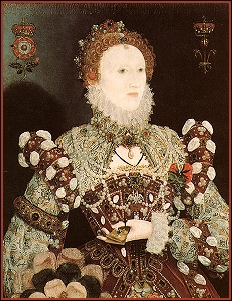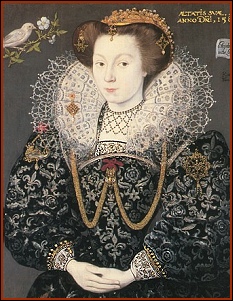


 Blackwork is a counted-thread embroidery worked in geometric
designs with black silk on even-weave linen. Black isn't the only
acceptable color for working these patterns (red or scarletwork
was also popular).
Blackwork is a counted-thread embroidery worked in geometric
designs with black silk on even-weave linen. Black isn't the only
acceptable color for working these patterns (red or scarletwork
was also popular).
The Elizabethans frequently called blackwork Spanysshe work, and it was traditionally believed that the craft had come into popularlity with the arrival of Catherine of Aragon at the English court. But in fact, there are references to black silk embroidery on body linen as far back as Chaucer.
The best way to get a feel for historical use of blackwork is to look at the many iconic portraits painted at this time (consult the bibliography for sources, or visit Tudor and Elizabethan Portraits and the Blackwork Gallery at The Elizabethan Practical Companion). Samplers or examplers are another good source. Long before they became the rote-exercises of schoolgirls, samplers were simply a needleworker's personal record of stiches and patterns.
A pair of blackwork sleeves with matching partlet (as worn by the Queen, above left) is
really beyond all but the most fanatical costumer; but even if your
time is limited you can make lovely period details. Some suggestions:


Blackwork is typically worked in the double-running or Holbein stitch, which is reversible. However, unless your work will be seen from both sides, you may also use the backstitch.
THE ILLUSTRATIONS:
Queen Elizabeth I, The Pelican Portrait
attributed to Nicholas Hilliard, c. 1575. Larger image.
Portrait of Elizabeth Brydges (detail), showing blackwork on cuffs and at the square neckline
of her smock,
by Hieronimo Custodis, 1589, from Tudor
and Elizabethan Portraits. Larger image.
Detail of a scarletwork cuff, portrait of Mistress St Lo, later Bess of Hardwick, Countess of
Shrewsbury, 1560s. [Misidentified as Mary Tudor.] She is wearing a scarletwork chemise (or possibly partlet
and sleeves). Collar detail.
Full portrait.
Detail of a blackwork cuff, portrait of Jane Seymour by Hans Holbein, 1537.
Larger image.